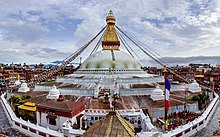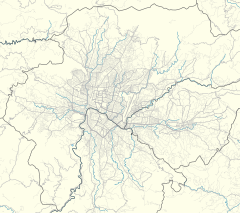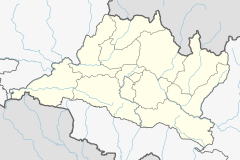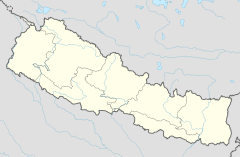
Back Stupa Boudhanath BAN Боднат (ступа) Bulgarian বৌধনাথ স্তূপ Bengali/Bangla Boudhanáth Czech Bodnath German Μποντνάθ Greek Baŭdanato Esperanto Boudhanath Spanish Bauddhanāth Estonian Boudhanath Basque
| Bouddha Stupa | |
|---|---|
बौद्धनाथ खास्ति माहाचैत्य | |
 Full View of "The Great Stupa" | |
| Religion | |
| Affiliation | Buddhism, Hinduism |
| Location | |
| Location | Kathmandu, Nepal |
| Geographic coordinates | 27°43′17″N 85°21′43″E / 27.72139°N 85.36194°E |
| Architecture | |
| Type | Stupa |
| Height (max) | 36 metres (118 ft)[1] |
| Official name: Bauddhanath, part of Kathmandu Valley | |
| Type | Cultural |
| Criteria | iii, iv, vi |
| Designated | 1979 (3rd session), revised 2006 |
| Reference no. | 121bis-005 |
| State Party | |
Bouddha (Nepali: बौद्धनाथ; Newari: खास्ति चैत्य; Standard Tibetan: བྱ་རུང་ཁ་ཤོར།, romanized: Jarung Khashor, Wylie: bya rung kha shor), also known as Boudhanath, Khasti Chaitya and Khāsa Chaitya is a stupa in Kathmandu, Nepal.[2] Located about 11 km (6.8 mi) from the center and northeastern outskirts of Kathmandu, its massive mandala makes it one of the largest spherical stupas in Nepal[3] and the world.
The stupa is said to entomb the remains of Kassapa Buddha.[4] It is located on the ancient trade route from Tibet which enters the Kathmandu Valley by the village of Sankhu in the northeast corner and continues to the ancient and smaller stupa of Chabahil named Charumati Stupa (often called "Little Boudhanath"). It then turns directly south, heading over the Bagmati River to Lalitpur, bypassing the main city of Kathmandu (which was built later).[2] Tibetan merchants have rested and offered prayers at Boudha Stupa for many centuries. Following the 1959 Tibetan uprising, a large number of the Tibetan refugees migrated to Nepal and settled down around Boudhanath.[5] The influx of the Tibetan refugees has seen the construction of over 50 gompas (Budhhist monasteries) around Boudha. As of 1979, Boudha Stupa is a UNESCO World Heritage Site. Along with Swayambhu, it is one of the most popular tourist sites in the Kathmandu area.
- ^ Department of Archaeology (Nepal). "Bouddha Stupa". Retrieved 3 May 2014.
- ^ a b Snellgrove, David. Indo-Tibetan Buddhism: Indian Buddhists and Their Tibetan Successors, 2 vols., p. 365. (1987) Shambhala Publications, Boston. ISBN 0-87773-311-2 (v. 1); ISBN 0-87773-379-1 (v. 2).
- ^ "Fables of Boudha Stupa and Changunarayan". The Independent, Nepal News. X (26). 16–22 August 2000. Archived from the original on 2007-02-09.
- ^ Samvaw, Padma. "The History of the Great Jarung Kashor Stūpa". lotsawa house.
- ^ Prasad, Madhav (2023-06-09). "Major attractions in Nepal". Mosaic Adventure. Retrieved 2023-06-25.
© MMXXIII Rich X Search. We shall prevail. All rights reserved. Rich X Search


